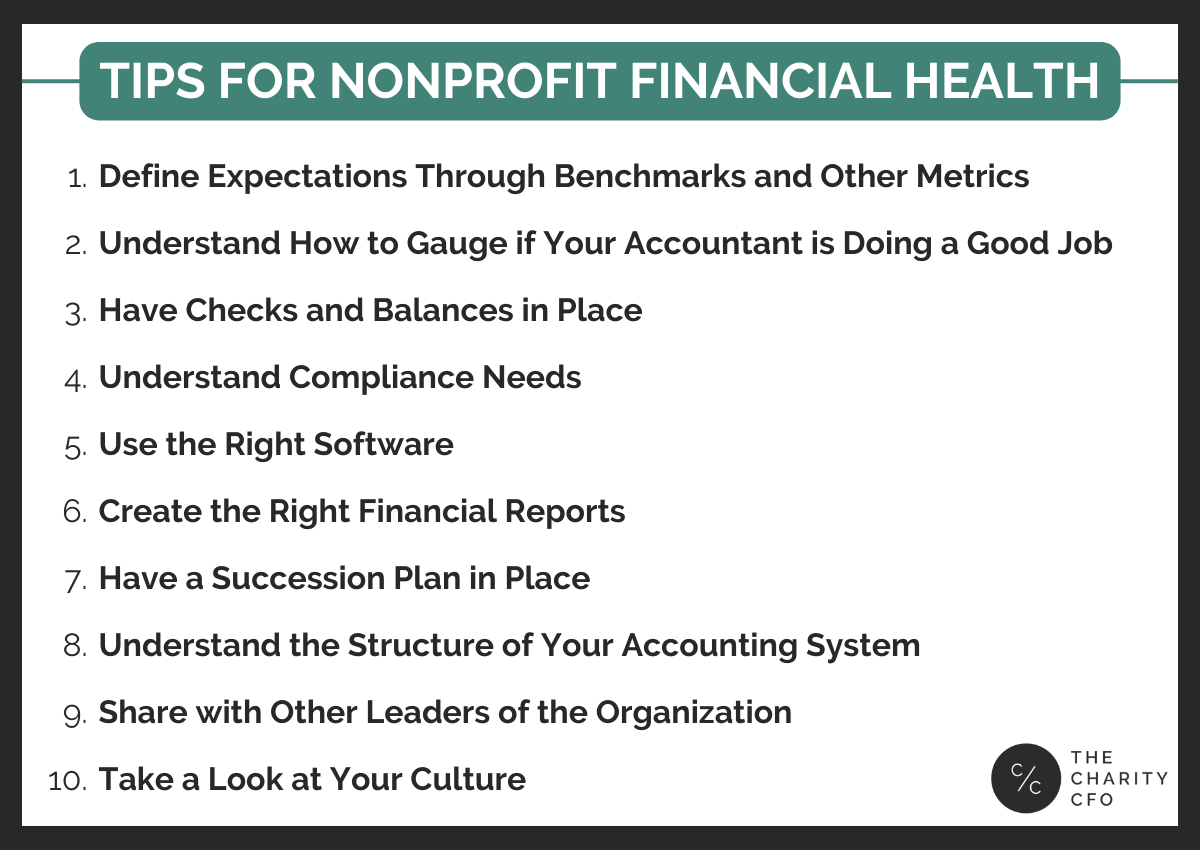Just like a human body’s health situation can be complex, nonprofit financial health is similarly nuanced.
That’s why staying financially healthy and keeping your nonprofit in tip-top shape requires the occasional “checkup” to see where you’re doing well and where you can improve. So what steps should nonprofit leaders take to ensure their organization will enjoy many happy years to come?
Read on as we explore some of the top strategies.
Master Your Nonprofit Financial Health with These Tips
Preserving your good nonprofit financial health is surprisingly straightforward. Try these ten tips for the most significant impact.
1. Define Expectations Through Benchmarks and Other Metrics
Before you can figure out if your nonprofit is healthy, you have to define what healthy means to your organization.
Work with stakeholders like donors, fundraising heads, program leaders, and others to determine what metrics and benchmarks should be used. By clearly identifying these indicators, it’s easy to see when one area is falling behind and take swift action to correct it.
These expectations should be realistic but also provide a goal for your team to strive for.
2. Understand How to Gauge if Your Accountant is Doing a Good Job
Unfortunately, too many nonprofits allow their accountants to take care of business with little oversight. While this may be easy, it can also result in missing out on critical tax savings or, worse, exposing your organization to an audit for breaking the rules.
Keep in touch with your accountant and ensure you’re asking questions about what they’re doing and why. If they can’t provide good answers, it may be time to switch.
Understanding the unique roles within your financial team is also crucial to the success of your nonprofit. Bookkeepers are not the same as accountants, just as staff accountants are not the same as Chief Financial Officers (CFOs). Each plays a distinct role in maintaining and enhancing your organization’s financial health.
3. Have Checks and Balances in Place
Every successful organization needs ways to check the influence of any individual member or department. This ensures all perspectives and impacts of decisions and programs are considered. Without these balances, leaders or others with influence can make decisions that don’t align with the organization’s over-arching goals.
4. Understand Compliance Needs
Compliance is an often underrated key to a thriving nonprofit. Mastering these technical issues and requirements is critical to:
- Avoiding audits
- Keeping donors’ confidence
- Securing various grants and other funding
In some cases, neglecting compliance with state or federal requirements can even lead to your doors being shut.
5. Use the Right Software
It can be difficult to do the job correctly without the right tools, and these days, the right software is a critical tool.
Your accounting and bookkeeping programs should be easy-to-use and have the appropriate features for an organization of your size. Consulting with an accountant who specializes in nonprofits is a great way to ensure you’re using the right software.
6. Create the Right Financial Reports
With the many features of modern accounting and bookkeeping software, the amount of information and reports available can be overwhelming. However, a few matter more than most.
Talk with your financial staff and accountant to figure out which you should be spending the most time creating and reviewing. This is vital for avoiding information overload.
7. Have a Succession Plan in Place
The best and healthiest nonprofits live on for decades or longer, far past the leadership and lifetime of their founders. They can do this because the critical members of the organization have proper succession plans.
Younger leaders should be given more responsibility over time to prepare them for more senior roles, and current longtime heads should have clear plans for how and when they hope to hand off the reins. On the financial side, there are systems and processes that need to be in place, so make sure you consult with an accountant to get these sorted out.
All of this ensures a smooth transition when the time for a change comes, planned or unexpectedly.
8. Understand the Structure of Your Accounting System
Even if financial issues aren’t your particular skill set, nonprofit leaders need to understand how their accounting system works.
It lends important insights into decisions about programs or other aspects of the organization and can help in conversations with donors who may have more detailed financial questions.
9. Share with Other Leaders of the Organization
If this all seems like a lot to handle on your own, it’s because it is.
Bring in other leaders to help manage the burden of keeping your nonprofit financial health in good shape and enjoy the bonus benefit of their added insights. This goes hand-in-hand with a succession plan but also helps improve nonprofit operations in the meantime, as well.
10. Take a Look at Your Culture
At the end of the day, keeping a nonprofit healthy from a financial perspective requires the buy-in of all employees, donors, and other stakeholders.
It’s a comprehensive mindset that focuses on maximizing always-limited resources and ensuring waste is minimized as much as possible. The rewards can be felt every day with an improved ability to carry out your organization’s goals and mission.
How is Your Nonprofit Financial Health?
As with your body, there’s no sense in putting off your nonprofit financial health checkup. Consider these key issues now, and you may be shocked at the improved performance of a “healthier” organization.
But we realize these issues can be complex and time-consuming, so The Charity CFO is here to help. Contact us today to get started with our experienced financial professionals, who’ll set your nonprofit up for many healthy, happy years to come.

Do You Struggle to Make Sense of Your Financial Statements?
Get our FREE GUIDE to nonprofit financial reports, featuring illustrations, annotations, and insights to help you better understand your organization's finances.
Get the free guide!



0 Comments